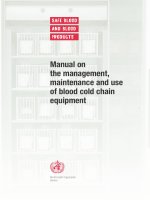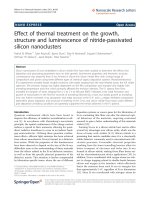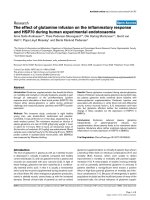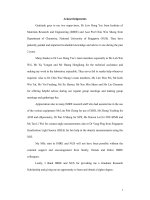Effect of hot air oven drying on the moisture kinetics and drying rate of osmo-dried papaya (Carica papaya L.) slices
Bạn đang xem bản rút gọn của tài liệu. Xem và tải ngay bản đầy đủ của tài liệu tại đây (376.62 KB, 7 trang )
Int.J.Curr.Microbiol.App.Sci (2019) 8(2): 1945-1951
International Journal of Current Microbiology and Applied Sciences
ISSN: 2319-7706 Volume 8 Number 02 (2019)
Journal homepage:
Original Research Article
/>
Effect of Hot Air Oven Drying on the Moisture Kinetics and Drying Rate of
Osmo-Dried Papaya (Carica papaya L.) Slices
Vikrant Kumar*, Jaivir Singh, Ratnesh Kumar, Sunil and Vipul Chaudhary
Department of Agricultural Engineering, SVPUAT, MEERUT (UP), India
*Corresponding author
ABSTRACT
Keywords
Hot air oven dryer,
Osmo-dried papaya
slices, Moisture
content, Drying
rate, Self life,
Chemical activities,
etc.
Article Info
Accepted:
15 January 2019
Available Online:
10 February 2019
The experiment was conducted to determine the drying rate, moisture
content of osmo-dried papaya slice. Drying of papaya slices in a hot air
oven dryer takes only 660 minutes for drying from an initial moisture
content of 89% (wb) to a final moisture content of 6.92, 4.84, 7.19 and
2.79% (db) of 55 oBrix and the final moisture content were recorded of 65
o
Brix that 16.30, 4.12, 9.32 and 9.76% (db) for T1, T2, T3 and T4 samples.
The drying temperature is the main factor controlling the rate of drying. It
is an important parameter for internal water transfer in the product.
Introduction
Hot air drying often degrades the product
quality, provides low energy efficiency and
lengthy drying time during the falling rate
period. It has been reported that hot-air drying
of food materials, involving their prolonged
exposure to elevated drying temperatures,
results in substantial deterioration of such
quality attributes as color, nutrient
concentration, flavor and texture (Zaki et al.,
2007). In the process, more water than solute
is usually removed due to the deferential
permeability of cellular membranes (Mauro
and Menegalli, 2005). Drying is a technique
of conservation that consists of the
elimination of large amount of water present
in a food by the application of heat under
controlled conditions, with the objective to
diminish the chemical, enzymatic and
microbiological activities that are responsible
for the deterioration of foods (Barnabas et al.,
2010). Water removal is the main task while
preserving food (Lenart, 1996) reducing the
moisture contents to a level, which allows
safe storage over an extended period of time.
Dried foods also present low storage and
transportation cost when compared to the
1945
Int.J.Curr.Microbiol.App.Sci (2019) 8(2): 1945-1951
fresh ones (Okos et al., 1992). The increase in
drying rate and decrease of heat transfer
provide energy saving of microwave drying.
Drying is perhaps the oldest, most common
and most diverse of chemical engineering unit
operations in the preservation of agricultural
food materials or products (Dincer, 1996). It
is the process moisture (water) removal from
substances due to simultaneous heat and mass
transfer (Waewsak et al., 2006). The
mechanism of drying process consist of the
transport of (mass) moisture from the interior
of the solid to the surface, the vaporization of
liquid at the surface (diffusion) and the
transport of the vapor into gas phase (Seyed et
al., 1999). The drying operation reduces the
moisture content of solids to a condition
favorable
for
safe
storage
without
deteriorations. The most significance reason
for the popularity of dried products is that in
dehydrated foods, microorganisms practically
do not grow due to the presence of a
minimum amount of water and thus they are
immune to enzymatic reactions that could
provoke alterations or spoilage in the food
(Agarry and Owabor, 2012; Hatamipour et
al., 2007; Gumus and Ketebe, 2013).
Materials and Methods
Experimental plan
Papaya slices were pretreatment with
treatments (T1 = Control, T2 = Potassium
Metabisulphate, T3 = Sodium bisulphate and
T4 = Blanching at 95oC for 4 min.) in osmotic
solution at temperature of 50°C. Then the
samples were dried under Hot Air Oven drier
at 60oC temperature. During the process,
osmosis was carried out in sucrose solution at
a varying concentration of 55°Brix and
65°Brix. At each experimental condition,
osmotic dehydration was carried out for 180
minutes and data are observed at each 30 min
intervals.
Experimental procedure
The papaya was procured from the local
market of Meerut (UP) in 2018. The papaya
was then washed, and decides into
2.5x2.5x2.5 cm Size. The papaya slices were
treated above decided treatments for 30
minutes and then the sample were removed
from treated solution and placed at room
temperature for 15 minutes and then weighted
by electrical balance.
After that the samples were osmosed with
sugar solution (55oBrix and 65oBrix) for 180
minutes at 50oC temperature and then the
osmo-dried papaya slices were dried in Hot
Air Oven drying at 60oC.
Moisture content
Moisture content of the sample was
determined by standard air oven method
(Rangana, 2001). Test sample of 5 g was kept
for 16-18 hr in a hot air electric oven
maintained at 100ºC. After 16-18 hr, sample
was drawn from the oven and placed in a
desiccator for cooling. After cooling the
weight of the sample was taken precisely. The
loss in weight was determined and moisture
content was calculated using the following
expression:
×100
× 100
Where,
M0 = Initial weight of sample taken, 5 g
M1 = Weight of sample before tray drying
and weight of dish with cover, g
M2= Weight of the dish with cover containing
dried and desiccated sample, g
1946
Int.J.Curr.Microbiol.App.Sci (2019) 8(2): 1945-1951
Drying rate
Drying rate will be calculated as weight of
water removed per unit time per unit weight
of the bone dry matter.
Results and Discussion
Effect of moisture content during drying
Fresh Papaya of good and uniform quality
was obtained from a local market
(Modipuram). The average initial moisture
content was 89% (wb) and soluble solids
content was 15⁰Brix (Singh, 2015). The
effects on moisture content during drying of
osmosed dried papaya slices under tray dryer
at 60oC. The result presented in table 1 and
figure 1 and 2. Moisture content followed a
slight decreasing trend as the drying period
increases. The variations in moisture content
of osmosed dried papaya slices with time
were ranged from 750.79 to 6.92 (T1), 223.67
to 4.84 (T2), 245.52 to 7.19 (T3) and 235.93 to
2.79 (T4) of 55oBrix from 0 to 660 minutes,
while the variations of moisture content were
ranged from 772.73 to 16.30 (T1), 251.81 to
4.12 (T2), 371.89 to 9.32 (T3) and 297.36 to
9.76 (T4) of 65oBrix from 0 to 660 minutes.
The moisture content decreased as time
increases but tend to be constant with further
increase in time. The loss in water content of
a sample is depending on drying time. In
general the time of treatment increase, the
weight loss increased but the rate at which
this occur decrease (Kumari et al., 2013).
Table.1 Effect of treatments and hot air oven drying (60oC) on moisture removal of osmo-dried
papaya slices
Time
(min.)
T1
T2
T3
55oBrix
65oBrix
55oBrix
65oBrix
55oBrix
65oBrix
55oBrix
65oBrix
0
750.794
772.73
223.674
251.814
245.521
371.893
235.928
297.36
60
693.107
717.014
192.081
204.029
211.71
265.386
179.933
223.055
120
644.87
661.43
150.099
164.984
172.269
192.958
145.531
177.847
180
457.556
569.834
109.918
117.122
137.12
153.733
98.2839
116.904
240
337.358
456.806
82.46
76.4046
105.985
104.066
65.694
78.4525
300
207.882
312.347
63.0009
56.3851
80.1418
67.1157
49.9151
62.9765
360
155.705
243.708
48.4005
47.3862
60.6738
52.293
39.2297
47.4985
420
86.2215
156.356
36.7031
35.4526
48.4046
37.4874
31.3507
36.0728
480
58.5348
113.161
27.1505
28.2689
34.6726
30.3976
23.5977
29.0476
540
30.8531
71.2687
21.7458
18.9684
28.9341
22.3196
16.2551
22.8556
600
15.1898
53.6365
14.5062
11.2199
19.4922
16.4158
9.1887
16.6661
660
6.91823
16.3039
4.83995
4.11503
7.18553
9.32241
2.78857
9.76178
1947
T4
Int.J.Curr.Microbiol.App.Sci (2019) 8(2): 1945-1951
Table.2 Effect of treatments and hot air oven drying (60oC) on drying rate of osmos-dried
papaya slices
Time
(min.)
60
120
180
240
300
360
420
480
540
600
660
T1
T2
T3
T4
55oBrix
65oBrix
55oBrix
65oBrix
55oBrix
65oBrix
55oBrix
65oBrix
1.6144
0.90198
0.54063
0.50083
0.43159
0.16494
0.14544
0.05768
0.05126
0.02611
0.01253
2.06522
0.8629
0.4187
0.2784
0.1696
0.0648
0.0478
0.0278
0.0221
0.0208
0.0187
0.52655
0.34985
0.22323
0.11441
0.06486
0.04056
0.02785
0.01990
0.01401
0.01207
0.01065
1.23842
0.37673
0.33857
0.16022
0.05159
0.04299
0.02720
0.01464
0.01147
0.01056
0.01046
0.56351
0.32867
0.19527
0.12973
0.08614
0.05408
0.02921
0.02861
0.01863
0.01574
0.01065
0.92855
0.56321
0.48887
0.47195
0.47053
0.29066
0.20798
0.08999
0.07758
0.05939
0.02656
0.9333
0.2867
0.2625
0.1358
0.0526
0.0297
0.0188
0.0162
0.0136
0.0118
0.0097
0.79642
0.32537
0.26590
0.16966
0.06673
0.02800
0.02641
0.01797
0.01422
0.01291
0.01076
Fig.1 Effect on moisture content (db%) at 55oBrix during hot air oven
Fig.2 Effect on moisture content (db%) at 65oBrix during hot air oven drying
1948
Int.J.Curr.Microbiol.App.Sci (2019) 8(2): 1945-1951
Fig.3 Effect on drying rate at 55oBrix during hot air oven drying
Fig.4 Effect on drying rate at 65oBrix during hot air oven drying
Effect of drying rate during drying
The drying behavior of osmo-dehydrated
papaya slices was analyzed using the
experimental data of moisture of product.
Time interval varies from 0 to 660 minutes at
60oC temperature. The experimental data of
the drying behavior of dried papaya slices
with relation to moisture content, and drying
rate are show in table 2 and figure 3 to 4. It
was observed from the curves that the drying
rate was higher in the initial period of drying
and subsequently it was reduced with
decrease in moisture content. The drying in
falling rate period indicates that internal mass
transfer occurred by diffusion. Similar results
have been reported for the drying studies on
onion slices (Rapusas and Driscoll, 1995) and
apricots (Doymaz, 2004). The variations in
drying rate of osmo-dried papaya slices with
time were ranged from 1.61 to 0.013 (T1),
0.53 to 0.011 (T2), 0.56 to 0.011 (T3) and 0.93
to 0.009 (T4) of 55oBrix from 60 to 660
minutes, while the variations of drying rate
were ranged from 2.065 to 0.019 (T1), 1.238
to 0.010 (T2), 0.928 to 0.026 (T3) and 0.796 to
0.011 (T4) of 65oBrix from 60 to 660 minutes.
The drying rate cure decreased as time
increases but tend to be constant with further
increase in time. The higher drying rate at the
start of drying is due to high surface moisture
availability, which evaporates rapidly. Further
decrease in drying rate is owed to decrease in
available moisture due to low driving force
1949
Int.J.Curr.Microbiol.App.Sci (2019) 8(2): 1945-1951
and low moisture diffusion from center to
surface of the dried product. Similar results
were found by (Rocha et al., 1992). Drying
time provides an indication of drying rate.
Drying rate of the samples was high initially
when the moisture content was highest
(Kumari et al., 2013). The entire osmotic as
well tray drying took place in falling rate
period. The final moisture content of samples
basically depends upon initial moisture
content of the samples, if all conditions are
steady.
In conclusion, the drying curves were affected
by the drying air temperature. Drying rate was
observed from the curves that the drying rate
was higher in the initial period of drying and
subsequently it was reduced with decrease in
moisture content. The drying in falling rate
period indicates that internal mass transfer
occurred by diffusion. The drying temperature
has an essential role in the characterization of
drying behavior of papaya samples. The
increase in drying time consequently
decreases the drying rate. The higher drying
rate at the start of drying is due to high
surface
moisture
availability,
which
evaporates rapidly.
Acknowledgements
We would like to acknowledge the
department of agricultural engineering (S.V.P.
Uni. Agri. And Tech. Modipuram, Meerut)
for providing facilities to conduct the
experiment.
References
Agarry, S.E. and Owabor, C.N. (2012)
Modelling of the drying kinetics of
Banana under natural convection and
forced air drying. Journal of the
Nigerian
Society
of
Chemical
Engineers Vol. 27(1): 103-115.
Barnabas, M., Siores, E. and Lamb, A. (2010)
Non-thermal microwave reduction of
pathogenic
cellular
population.
International
journal of
Food
Engineering 6:1-18.
Dincer, I. (1996) Sun drying of sultan grapes,
Drying Technology, 14: pp. 18271838.
Doymaz. I. (2004) Effect of pre-treatment
using potassium metabisulphite and
alkaline ethyl oleate on the drying
kinetics of apricots. Biosystems
engineering, 89:281-287.
Gumus, R.H. and Ketebe, E. (2013) The
Effect of Temperature on Drying Rate
of Agro Food: Corn (Maize) and
Ogbono (Irivingia gabonnensis).
Journal of Engineering, Vol. 3(3): 3642.
Hatamipour, M.S., Kazemi, H., Nooralivand,
A. and Nozarpoor (2007) Drying
characteristics of six verities of sweet
potatoes in different dryers. Trans
Chemical Part C. Food and
Bioproduct processing. Vol. 85(3):
171-177.
Kumari, D., Chandra, S. and Samsher (2013).
Assessment
of
mass
transfer
properties during osmotic dehydration
of ripe banana slice. Beverage and
food world, 40(12): 39-42.
Lenart, A. (1996) Osmo-convective drying of
fruits and vegetables: technology and
application. Drying Technology, 14,
391–413.
Okos, M.R., Narsimham, G., Singh, R.K. and
Witnauer,
A.C.
(1992)
Food
dehydration. In: D. R. Heldman & D.
B. Lund (Eds.), Handbook of food
engineering. New York: Marcel
Dekker.
Ranganna, S. (2001). Hand book of Analysis
and quality control of fruit and
vegetable products. Tata McGraw Hill
Pub. Co. Ltd. New Delhi
Rapusas, R.S. and Drisoll, R.H. (1995)
Thermo physical properties of fresh
1950
Int.J.Curr.Microbiol.App.Sci (2019) 8(2): 1945-1951
and dried while onion slices. Journal
of Food Engineering, 24: 955-963.
Rocha, T., Lebert, A. and Audoin, C.M.
(1992) Effect of drying condition on
color of mint and basil (Oumun
basilium). A.S. Muyumber (Ed), pp.
1360-66.
Seyed,
J.Y.,
Moreira,
R.G.
and
Yamseangsung,
R.
(1999)
Superheated
steam
impingement
drying of tortilla chip. Drying
Technology. No 17 page 191-213.
Singh, E., Kalyani, B., Reddy, B.S., Kalyani,
P.U., Devi, V.H., Ravi, L. and Shanti,
M. (2015). Study On dehydration of
Papaya
Slices
Using
Osmotic
Dehydration Mediated Hot Air Oven
Drying.
IOSR
Journal
of
Environmental Science, Toxicology
and Food Technology. Vol. 9(11): 7295.
Waewsak, J., Chindaruksa, S. and Punlek, C.
(2006) A mathematical modeling
study of hot air drying for some
agricultural products. Thammasat
International Journal of Science and
Technology, Vol. 11: pp. 14-20.
Zaki, N.A.M., Muhamad, I.I., Salleh, L.M.
and Khairudin, N. (2007) Drying
characteristics of papaya during
microwave-vacuum
treatment.
International Journal of Engineering
and Technology, Vol. 4(1):15-21.
How to cite this article:
Vikrant Kumar, Jaivir Singh, Ratnesh Kumar, Sunil and Vipul Chaudhary. 2019. Effect of Hot
Air Oven Drying on the Moisture Kinetics and Drying Rate of Osmo-Dried Papaya (Carica
papaya L.) Slices. Int.J.Curr.Microbiol.App.Sci. 8(02): 1945-1951.
doi: />
1951









